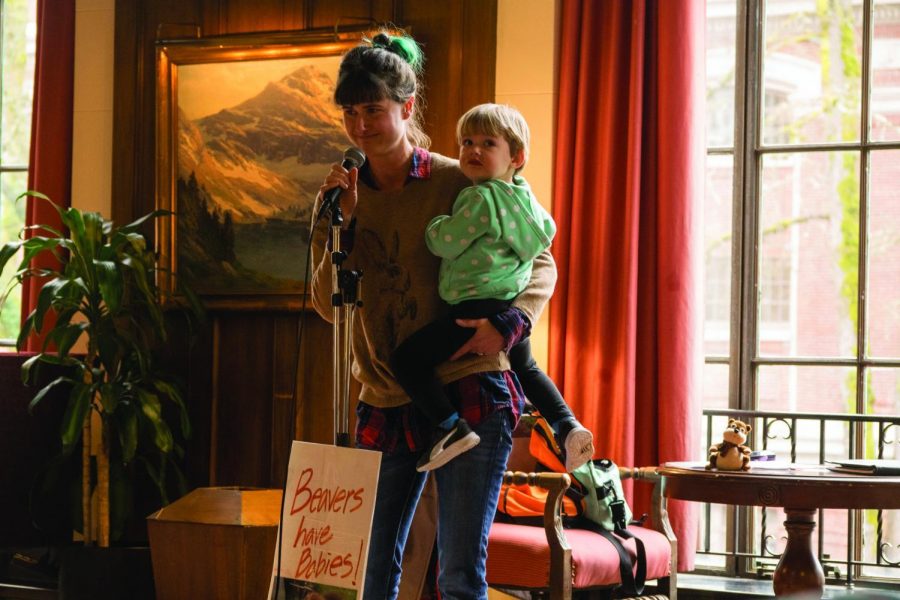OSU works to provide child care on campus
February 27, 2017
Community members convey lack of affordable, accessible care options
Families with children of all ages gathered in the Oregon State University Memorial Union living room, sipping on coffee and hot chocolate. The parents mingled and chatted while the kids fixated on OSU mascot Benny the Beaver as he cradled a stuffed baby beaver.
After ten minutes of socialization, the families settled onto couches or the floor. The ‘Beavers Have Babies, Dam It!’ rally and march had begun.
Several speeches surrounding OSU childcare started the rally. After each had spoken, the floor was open to any attendees that wanted to share their story.
After the stories were shared, the group headed out to march across campus. The student and staff parents participated in chants, waved signs and banged on pots with spoons.
Child care is a costly service that many parents utilize. This service is especially draining on student and staff families, a growing demographic within the Oregon State University community. While the university has plans to provide resources to student parents, some parents do not believe enough is being done in the present.
The President’s Commision on the Status of Women organized the event ‘Beavers Have Babies, Dam It!’ to convey a sense of urgency surrounding the perceived lack of accessible and affordable child care, according to Amber Ahlgren, a member of the PCOSW.
“We are calling on the university to be a leader,” Ahlgren said. “They are actively working, but we need to push the urgency. We need to make a commitment to child care.”
While Ahlgren’s husband is a stay-at-home father, meaning they do not need child care services, she cares deeply about the issue, as she witnesses fellow parents struggle to find child care.
“I’ve seen students dropping out or taking six or seven years to complete their degree, and it seems more and more
frequent,” Ahlgren said.
According to the 2016 OSU Child Care Needs Assessment Survey, there has been a 92 percent increase in the number of OSU students with infants and a 33 percent increase in the number of students with children under the age of 12 since 2014.
The current OSU child care systems cost less than the community standard, but that may not be enough, according to Amy Luhn, the director of childcare and family resources at OSU.
“Quality childcare is expensive to provide, it’s predicated on low teacher-child ratios and well-educated trained staff and that costs money,” Luhn said. “And yet parents can’t actually afford to pay the cost.”
Childcare and Family Resources currently has about $150,000 to help OSU student families, which means so far this academic year, 73 student families have received financial support, and CFR has the potential to help more throughout the year. according to Luhn. Last year, 90 student families were supported.
However, with limited space in OSU’s daycares, parents often have to seek child care off campus. According to Estefania Ellorriaga, a fifth-year doctoral student in the molecular and cellular biology program, she ended up on the waitlist of every child care center in Corvallis, including OSU’s childcare center Beaver Beginnings, for her now six-month-old daughter.
“We assumed we were going to get her in Beaver Beginnings,” Ellorriaga said. “My husband has a full-time engineering job, so we can afford off-campus daycare, but 70 percent of my stipend goes straight to her day care.”
Currently, OSU students and staff have accommodations offered through the Childcare and Family Resources, including family housing options, lactation rooms and the child care centers. Administrators are also focused on potential solutions to the lack of accessible care, according to Ahlgren.
Luhn is working on finding ways to meet the demand for child care, including meeting with people who have previously donated to child care at OSU.
“We’re finishing creating an infographic and trying to look at re-engaging those initial donors and looking at an aggressive buildup of funds available to be dispersed,” Luhn said.
One community member, Robbin Stevenson, is planning on forming her own solution after years of working in education and child care. She uses nannies to care for her three children, as she has been unable to find affordable child care. Stevenson will also have other parents drop off their kids at her house and share her nanny, as she understands the difficulty of finding child care.
“For putting one child in child care, you’re looking at $1200 for full time,” Stevenson said. “It’s not affordable.”
Stevenson is planning on creating her own child care center in Corvallis. She would tailor the facility to the needs she has identified through working in child care. To make the center accessible to everyone, Stevenson is considering pursuing nonprofit status.
“Nonprofit status is very difficult, but you get access to federal funding and grants,” Stevenson said.
Stevenson is also interested in utilizing fundraising to create her center.
“It’s going to take the community coming together for this,” Stevenson said.
























































































































